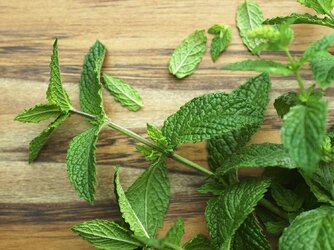No ask, just share! I want to know.
Here we go!

First of all, it's important to identify the ideal type of mint that we would like to use for all of these purposes.
Identifying Mint:
For decades throughout the Western World, horticulturalists have periodically misidentified what is mint, what is spearmint, and what is peppermint. Partially due to this reason, it's difficult to find the right species of mint.
There's a type of mint that's covered in light sugar spots all over the leaves. This is known as pineapple mint. It's almost useless but, like all mint, can be dried and used as kindling to start fires and barbeques. This type of mint is the only kind with the spots on it, so it's easy to avoid. It's not even really mint, in my opinion.
The type we want is the mint that's universally grown in the Mediterranean, as well as Yunan Province in China.
The life of Ibn Batutta solidified many years of trading between North Africa and Southeastern China, mostly having to do with green tea and mint, which continues on to this day. We'll get into that more later with
the traditional ancient mint tea recipe that's still popular.
So, how do we know it's the type of mint we want? We want a type of mint whose leaves smell the way pure sugar tastes. We should ask ourselves, "Does this smell the way sugar tastes? Does this give me that exciting sensation when I take a sniff?" If yes, we're on the right track and that's probably the right kind of mint.
Mint is a close cousin to marijuana. The type of mint we want does not smell like marijuana. There's two types of mint, on a spectrum. One type smells earthy and very much like a plant. Imagine tree bark. The other type smells sweet and and almost citrusy.
Aside from ensuring there are no spots on the leaves, there's no way to identify the right type of mint based on what you can see. It's all about the smell and the taste.
It took me three years to find the ideal, sweet mint in my area. In the time leading up to that, I could only find mint that was somewhere inbetween. Let me tell you how I judged it.
If you can smell the stem, and taste the stem, and them smell the leaves, and taste the leaves, if the taste of the leaves is drastically different and better compared to the stem, that's good mint (if it's not earthy, like we went over). If the leaves taste similar to the stem, that's bad mint and not the kind we want.
I wish I could just let you smell a leaf of the right kind of mint, but this is the limitation of the Internet.
Use in traditional medicine
In many cultures, including Traditional Chinese Medicine, mint is recognized as a natural remedy to nausea. If you're feeling sick, smelling mint leaves will alleviate the symptoms. Even better is making an herbal tea out of the fresh leaves. The smell is more aeromatic and consuming it is good for the stomach; it can act as a natural peptobismal, sometimes helping to alleviate diarhhea and the dehydration it causes.
It can also be used as a sleep aid. If you are ever extremely tired and you know you'll fall asleep as soon as your head hits the pillow, you can rub a mint leaf on your neck, pinch a leaf with your fingers, or use the leaves to make tea (simply by soaking them in hot water for two minutes and then removing them) and keeping the tea near you while you sleep. Since scent is so well-tied to memory, you can use this strong smell to bring you back to sleepiness when you want to sleep on another occasion. It's like a natural melatonin (and it's safe for kids). All you need to do is have the smell of mint around bedtime.
Mint also has anti-inflamatory properties and can help with heartburn. The tea is good for this.
Tea:
Steeping the leaves in boiling water for two minutes, in my opinion, makes the best herbal tea. This can be drank at night, as outlined above.
Adding a tea bag of Chinese green tea turns it into traditional North African mint tea, which a lot of people are nuts for and a lot of companies try to replicate under different branding. You can do this in a mug. Add sugar for the traditional African experience with the tea. So it's sugar, Chinese green tea, and fresh mint leaves. Very yummy and very aromatic.
Mint-fried food:
You can fry mint in oil, in a skillet, then add chicken wings. Or in this case, beef spare ribs:
It's great how the mint flavors the oil. No matter what, you fry the meat for six minutes. It's delicious.
Mint simple syrup:
Making this is easy. Adding it to some ice and some bubly sparking water or La Croix makes the best soda.
Chicken Spiedies (Speedies):
This is a delicious recipe celebrated every summer in New York. It all depends on a tangy mint dressing, used both as a chicken marinade and sauce on the sandwich.
Mint is in season right now and can be up to waist-high.
Enjoy mint, everyone!









